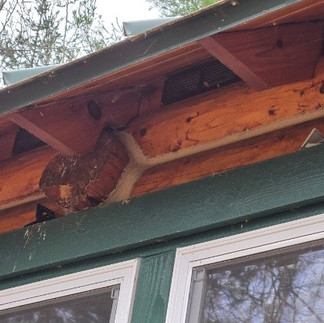Michigan Forest Life - November 9, 2025
- angienikka
- Nov 9
- 4 min read
Good morning, friends,
I sensed winter in the air when I left Winterfield Pines Nature Sanctuary a few days

ago. Perhaps it was temperatures flirting with the freezing mark each morning. Perhaps it was the late fall aroma imprinted in my brain, instinctively reminding me that this smell is followed by snow. Maybe it was a subconscious reaction to the breeze. Its direction. Its gentle bite. The feel of what cannot be seen.
“Soon,” Mother Nature said in her subtle way. “Listen. Get Ready!”
I knew I was finishing the Treehouse construction improvement just in time.
This morning it is here (Photo 1).
The forest animals sensed it too. Vees of Canada geese flying south. Lines of migrating sandhill cranes. All the animals are aware. How do they know? Do they remember cyclical seasons they have seen before? Do they know the timing is right? Does a phase of the fall moon toggle a winter switch in their brains? Is it the disappearance of insects in the forest? The appearance of acorns on the ground? The reduction in daily sunlight? The wilting of ferns in the forest’s understory? Ancient patterns understood by generations of living things...even in their first season.
I noticed a family of mice preparing. I did not see the mice at first. I saw a few specks of pink insulation on the ground under the Bunkee’s north window. Where did that come from? The following day I saw a small tuft of the insulation blanketing a bird’s nest resting on the stub of a crossbeam that protruded through the Bunkee wall above the window – an abandoned bird’s nest sheltered by the eave. A mouse ran along the edge of the window trim and disappeared at the window’s edge. As I leaned a ladder against the Bunkee’s wall another mouse appeared on the trim edge. I brushed it to the ground. I gently reached for the tuft of insulation on the bird’s nest, and then the nest itself. A mouse inside the nest jumped to the ground.
I was amazed at what a perfect mouse home this was. A warm bird’s nest, blanketed in insulation. But it had to go. Too bad.
So, where did the insulation come from? I checked all of the log intersections. The chinking was perfect. I checked the wall edge at the roof – perfect! Perhaps you remember that when constructing a log home a gap is generally left above each window frame so that the wall of logs can shrink naturally without being obstructed by the window frame, which does not shrink with the logs (Photo 2). During construction, I filled the gap with insulation and covered it with flexible flashing. The top trim board of the window attached to the logs then slides over a bottom trim board attached to the window frame as log shrinking takes place (Photo 3 and 4).
The mouse found a way into the gap at the end of the trim boards. I think I solved the problem by pushing steel wool into the opening the mouse was using. I must say, I was charmed by the ingenuity of this family of mice and their bird’s nest home. I felt bad evicting

them just before winter, but the Bunkee is for humans, not mice. We must coexist in another way. The coexistence of humans and wild animals can be a tricky thing for humans living in civilized ways. I do not think wild animals have the same problem with humans that humans have with animals.
Today I include preview snippet 7 of 27 from FOREST LEGEND: THE TALE OF OL’ SPLIT TOE (Photo 5).
I wish you a warm shelter on a winter day.
Until next time,
Dan
FOREST LEGEND: THE TALE OF OL’ SPLIT TOE
By Dan Ellens
Snippet 7 of 27
AD 1870 - From birth, Split Toe had learned to never sleep too deeply. He was out of action for now, but his senses remained alert. That night, though the water numbed the pain of his injured leg, he did not rest well in the river. A few heavy logs floating by disturbed him. One came close enough to bump him gently toward the riverbank as it followed the current downstream. Split Toe was only half asleep when he woke to the sound of a loud whack just after daybreak—and to the smell of smoke.
Whack. Whack.
Without leaving his position, Split Toe watched through the brush as several humans worked on the opposite side of the river. These humans were different from any he had seen before. They did not look as though they belonged in the forest. Their bright clothing, loud voices, and forced way of movement did not blend in. They walked with loud, heavy steps, their feet wrapped in solid dark covers. Not flexible, soft moccasins. They seemed to do everything the hard way, without simple elegance to their motion. And they had hairy faces. Very hairy faces.
Each man used a long stick with a wide tooth on the end to cut through a mighty white pine. They felled a tree much larger and older than a beaver could have managed. A tree that had defied wind, snow, flood, drought, disease, and decay for 450 years. A tree that harbored countless nests of birds and squirrels as it stood like a permanent tower in the forest, formed by nature into a sentinel for its species. A tree with many generations of offspring, wisdom etched into the patina of its rough bark.
Excerpt from Chapter 9
Copyright @ 2025 by Daniel S. Ellens
Presale Release date: November 25, 2025
Publication Date: March 31, 2026
Praise for FOREST LEGEND:
“Forest Legend: The Tale of Ol’ Split Toe provides a unique perspective on the natural world and humanity’s place in it. Through charming storytelling and deep reverence for Mother Nature, the book both entertains and inspires a fresh look at the world that surrounds us.”
– Mary Radcliffe, Self-described forest enjoyer and frequent hiker, Chairperson of Data Science at State Navigate.








Comments